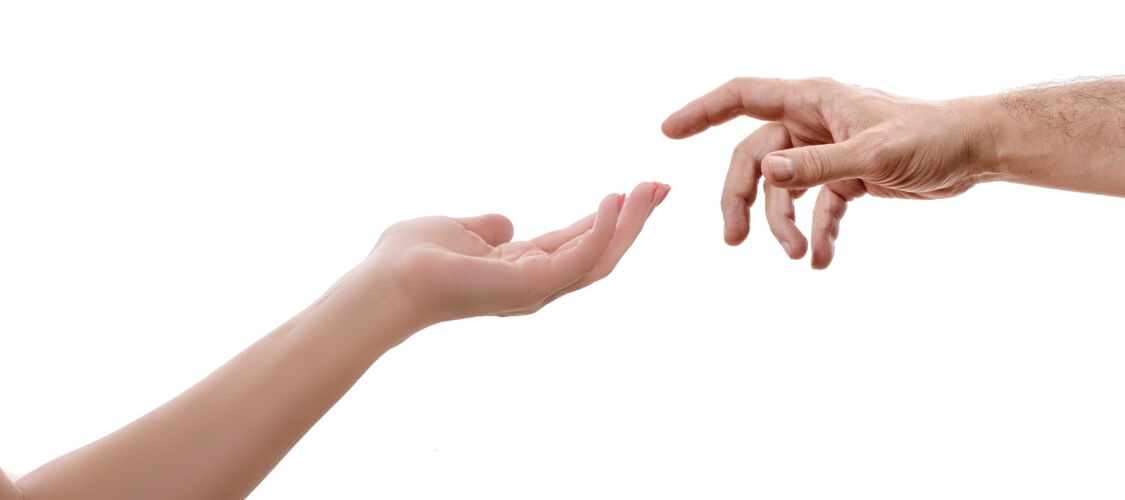Dupuytren’s Disease and Finger Contractures
Although the cause of Dupuytren’s disease is still unknown, we do know that the condition is hereditary. Joint research on the genetic roots of the illness by the Universities of Cologne in Germany and Groningen in the Netherlands, has been able to determine the chromosome which holds the information on this disorder.
To date, no significant influence of risk factors such as diabetes mellitus, alcohol or smoking has been established in the genetic material (1).
Over the course of months or years, nodules or cords are formed continuously or in surges in the palm and / or fingers. The fingers affected begin to contract noticeably and complete stretching at the base and middle joints is no longer possible. The severity of the contractures increases, potentially leading to a condition in which the fingertips make contact with the palm and become locked in this position.
As the condition develops not only do the fingers become increasingly disabled, they can also become a hinderance in certain situations, such as at work, during sport, with regard to personal hygiene or when playing a musical instrument.
Since 1994 I have been using a minimal invasive corrective measure on outpatients, under local anesthetic, the Percutaneous Needle Fasciotomy (PNF). This treatment not only delivers equally good results as open surgery, but is better because it:
- Reduces healing time to a few days instead of weeks or months as is common with open surgery
- Reduces the danger of postoperative bleeding and wound healing disorders as may be incurred with incisions from open surgery.
- Avoids uncomfortable and potentially painful dressing changes.
- Full functionality of the hand is regained much quicker than after open surgery. Occupational or physio- therapy are not required.
- Enables repeated treatment by PNF, as is deemed necessary. Each additional treatment is as straightforward as the original.(19) In contrast, open surgery leads not only to surface scars from the incision but also to scarring deep down in the tissue. This scarring makes each additional hand operation technically more difficult, and more prone to complication and pain.
Disadvantage of Needle Fasciotomy:
Recurrences i.e. a repeated contracture of the fingers, probably occur more quickly than after open surgery with its skin incisions (2).
Summing up, the advantages of the PNF are that it is minimal invasive and easily repeatable. Treatment as an outpatient and the reduction of time unfit for work are important socio- economic factors.
I am repeatedly asked why this method is not universally known and practised.
- Needle fasciotomy is an outpatient treatment, a stay in hospital is unnecessary. The medical insurance companies do not recognise hospitalisation for the PNF.
- Surgical procedures on outpatients are substantially poorly remunerated by the medical insurance companies and are thus uneconomical for the hospital owners.
- For the patients it is an advantage that a stay in hospital is avoided. But because of the shift to outpatient treatment trainee assistant surgeons are not able to learn this technique. The medical insurance companies dictate to the hospitals which operations are to be carried out at reduced costs as an outpatient and are thus no longer in their programme. This is a catastrophe for learning needle fasciotomy.
- The needle fasciotomy (PNF) does not require any subsequent medical treatment. In the case of the extensive needle fasciotomy (PNF+) with skin transplant, it is usually just three changes of dressing that the local GP or surgeon can carry out. Thus the potential for revenue, particularly from private patients is diminished in comparison to open surgery with its incisions that require a much longer subsequent treatment and longer time off work.
These are the main (economic) reasons why needle fasciotomy has remained in the shadow of open surgery with it’s incisions.
Money makes the world go round, and the medical profession is no exception.
A surgeon can only master this technique through years of practice on numerous patients. There is no certified training.
I myself know of only a few surgeons in Germany who have practised the PNF for 10 years or more, but unfortunately they still revert to open surgery on some patients. For me, open surgery is a thing of the past.
The PNF should not be performed halfheartedly, with open surgery always at the back of one’s mind.
Because of previous negative experience with Dupuytren’s contracture and open surgery, many GPs are reluctant to send patients for surgery. They send patients much too late, only then when fingers are decidedly bent. Needle fasciotomy is, however, best carried out when the fingers start to bend.
Before undergoing needle fasciotomy, patients must be informed that:
- Under local anaesthesia, a needle is used to perforate the substantial cords and nodules fan-shaped and tangential to the skin’s surface between skin and flexor tendon. Subsequently the contracture is broken open by passive stretching, ideally with an audible crack. This shocks some patients but there is no need for anxiety, nothing unforeseen has happened.
- Contractures in the base finger joints (MCP- joints) can usually be completely released by PNF. Contractures in the middle joints of the fingers (PIP-joints) can be released although not always fully (incidentally neither can this be achieved by open surgery, because in the course of Dupuytren’s disease so called secondary changes in the joint’s capsule or the tendon system can develop for which there is no treatment which promises success without risking joint fusion ).
- If the finger is pronouncedly bent or has been bent for a long time, the skin may no longer be elastic enough or may have grown together with the underlying cords or nodules. It’s then possible that the skin will tear in this position when the finger is passively stretched after the PNF. This is no cause for alarm. Small tears heal by themselves; tears larger than ca. 1cm are covered with a small piece of skin taken under anaesthesia from a hair-free position on the same lower or upper arm.
- In the case of a skin transplant, the fingers in question are placed in a 2- or 3-finger splint dressing for 8 days to enable healing whilst immobilised. If no skin transplant is necessary, the splint dressing may be removed on the day after the PNF. You are then able, if you wish, to play golf, tennis or work in the garden again
- The Push Hand Orthese DPT with it’s gentle tractive power is highly recommended to prevent a recurrence or to correct a residual contracture after PNF. It should be used during the daytime, for several hours at a time, over a period of months.
A patient from Berlin who is badly affected by Dupuytren’s disease, and who suffered recurrences on both little fingers after open surgery, developed this splint after 1½ years meticulous work following a PNF+ in 2015. The splints available at that time were both uncomfortable and ineffective. Link to presentation and (3). This Push Hand Orthese will be marketed in Autumn 2024 and available on prescription. For minor contractures the Push Hand Orthese DPT is the only therapy necessary.
With severe contractures it ensures a lasting success after a needle fasciotomy, and can, post-operative, further reduce contractures or as in the case of the patient from Berlin fully correct them.
The PNF is for me as a surgeon a considerable enhancement which alleviates my daily workload. Time and again, I am thrilled by this ingenious technique of straightening fingers which was developed and practised by the French 50 years ago. Patient satisfaction with this short surgical procedure, which apart from the local injections is essentially painless, is very high. Some are shocked when they hear sharp cracks during the procedure, but I explain to them beforehand that this comes from the fibrous cords and possibly the skin tearing. Vessels, nerves and sinews remain intact.
During the 90’s, I discovered that spontaneous skin tears, even >1cm, during the PNF were innocuous. I published this method which I termed the extensive needle fasciotomy, PNF+. Only with the PNF+ is it possible to correct severe finger contractures. The advent of the PNF+ made needle fasciotomy an alternative to open surgery, then now all Dupuytren patients, without exception, could be treated by this minimal invasive technique. A PNF+ treatment cannot be planned from the onset; it results out of a PNF when the skin is not elastic enough and badly scarred (e.g. as a result of open surgery).
Sometimes after the fingers have been straightened, the base or middle finger joints in particular swell up and remain swollen for a time. Similar to a torn capsule injury sustained during sport.
Nerves can be injured during a needle fasciotomy depending on whether they have the normal anatomical spiral form, where the fibrous cords lie, and particularly then when the patient has previously undergone open surgery and the nerves are entangled amongst the scar tissue where the needle cannot deviate. This causes a sensory disorder usually in the fingertips for a short time, seldom a long time. Flexor tendons are not pierced during needle fasciotomy, If however, they are caught up in scarred tissue resulting from open surgery, they may tear when severe contractures are passively stretched. This has happened just once with my 4000 patients,
Before a needle fasciotomy, the following points are clarified by telephone or eMail:
Whether medication to thin the blood is taken. With just one exception, patients may continue to take their anti-coagulants. For Marcumar, the patient’s GP must prescribe an alternative. So called ‘’bridging’’
Patients who arrive by car must have a driver for the return journey.
A substantial breakfast or lunch is allowed.
After the needle fasciotomy:
The 2- finger splint dressing is to be worn for 1 day after the PNF and for 8 days after the PNF+.
After the PNF+ the dressing has to be changed three times by the local GP or surgeon.
For insurance reasons patients must sign a written declaration which is printed in the appendix to this homepage.
Naturally this is no substitute for my face-to-face consultation in which I will answer all questions.
It is really quite unbelievable that contracted fingers can be straightened without even cutting the skin. In the 1990’s many of my colleagues must have thought that I was some sort of wizard or miracle healer when their patients told them that in Bielefeld treatment without skin incision was possible. I received many comments, some outrageous, from my ill-informed colleagues when patients told them they were going to Bielefeld to have their fingers straightened without open surgery. That was not always amusing, and there were only a few colleagues who were genuinely inquisitive and did not want to denounce me as a charlatan in front of their patients.
Right up until the end of my working life in 2024 it gave me great pleasure when a patient came to me with contracted fingers and I said ‚‘’ We’ll just straighten them out again’’. The times when patients shed tears of joy after a needle fasciotomy, which in a few minutes ended years of restricted movement, are long gone. These days people are much better informed about needle fasciotomy through the internet. They visit the patient forum of the German Dupuytren Society on dupuytren-online.de and select their doctor of trust. Well-informed patients come for treatment from all parts of Germany and even from abroad.
In future the treatment of Dupuytren’s disease does, not just belong to needle fasciotomy, or at least not to needle fasciotomy alone.
There is a realisation: the fibrous cords that cause the contracture can be stretched.
In Autumn 2024 the comfortable finger orthosis (Push Hand Orthese DPT) should be on the market.
With it, any eventually remaining contracture after a PNF can be straightened (12).
On no account should hands affected by Dupuytren’s disease be cut open. Unfortunately I am still the only surgeon who advocates this opinion . But then, I was alone once before with the needle fasciotomy and have been fighting against windmills for decades.
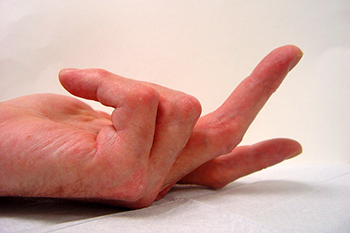
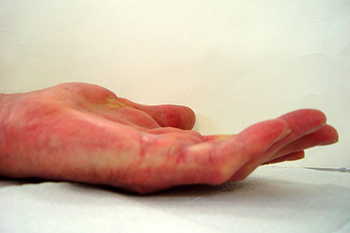
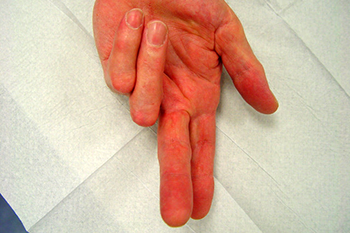
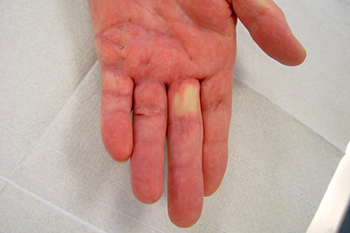
67-year-old patient with stage 4 contraction on the Tubiana scale, before and after the needle fasciotomy and after subsequent dynamic splinting.
The historical development of percutaneous needle fasciotomy (PNF) in treating Dupuytren’s disease.
The first scientific accounts about Dupuytren’s contracture were not from the Parisian surgeon Baron Guillaume Dupuytren (1777-1835) but from a student who made notes during lectures from the London surgeon Henry Cline Sr. (1750-1827). At a later point in time, but still before Dupuytren, Sir Astley Cooper (1768-1841) released a publication. Recently Felix Plater (1536-1614) from Basel has been named as the first author. The treatment described by the first London author in the 18th century was already minimal invasive. A drawing from Astley Cooper in an old dictionary of anatomy shows how a fibrous cord in the palm of the hand is severed by a small incision (fasciotomy). Back then the wound was not stitched but left open to heal (secondary wound closure). Incidentally, Henry Cline Sr. considered post-operative splinting a necessity.
At the turn of the 20th century, the radical resection of the diseased tissue in the hand established itself as the therapy of choice. A slight variation of this method, the partial fasciectomy, is practised to the present day. The fibrous cords and nodules are revealed by zigzag incisions, dissected and removed from the neurovascular bundles.
In 1959 J. Vernon Luck depicted subcutaneous fasciotomy as an alternative method to open fasciectomy for treating Dupuytren’s disease. Luck was, however, of the opinion that needle fasciotomy should not be used on the fingers (4).
The second half of the 20th century saw further developments and intensive use of the minimal invasive needle fasciotomy in France.
In 1993 Jean-Francois Badois and his team documented the needle fasciotomy which, in their opinion, was only applicable in the early stages of contracture (5).
In Germany, the orthopaedist K. Groeben was the first to publicise the PNF in 1993 (6). K.Groeben saw the PNF as an alternative to
an operation with the restriction that contractures in the middle joints (PIP-joints) could not be released by this method.
In 1997, looking back over the past 10 years, R.A. Duthie and R.B. Chesney saw the PNF as useful only for those patients who proved themselves unsuitable for the local radical fasciectomy (7).
In 1997 the PNF was for the first time described as the therapy of choice, in preference to the PF, by Jean-Luc Lermusiaux and his team (8). The authors were of the opinion that the PF should be reserved only for those patients who were dissatisfied with the outcome of a PNF. J.L. Lermusiaux also mentioned that a skin transplant could reduce the recurrence rate.
In 1994, K. Groeben demonstrated the PNF during a visit to Bielefeld.
For 10 years the PNF was conducted solely in Düsseldorf and Bielefeld.
The German hand surgeons first learnt about the PNF during the DGH-Congress in Hamburg in 2008. Albrecht Meinel delivered a presentation with the title “The percutaneous needle fasciotomy in the treatment of Dupuytren’s disease - first experiences’’.
More and more patients with increasingly severe contractures came to me, often after several previous operations. On no account did they want another operation. During the 1990’s I learnt that spontaneous skin tears which occur during the PNF are not a complication. Only the skin, scars and the fibrous cords tear; the more elastic neurovascular bundles remain intact. Larger tears do not require elaborate plastic correction and are easily repaired with a full-thickness skin transplant from the same arm (9,10,11). Since about the year 2000 I can, with the PNF and the PNF+, treat every contracture, including patients from previous open surgery who sometimes had such disfigured fingers that elsewhere amputation was planned. Such cases are of course difficult for me so that I am all the more pleased over the straightforward ones.
The patients sometimes find it difficult to believe how quickly and trouble-free success becomes apparent. This surgical activity gives me the greatest satisfaction, and patients become aware of this during the treatment.
Hands with Dupuytren’s disease should on no account be cut open anymore!
References
-
- Dolmans GHCG, Hennies HC. The Genetic Basis of Dupuytren´s Disease: An Introduction. In: Eaton C, Seegenschmiedt MH, Bayat A, Gabbiani G, Werker P, Wach W, eds. Dupuytren´s Disease and Related Hyperproliferative Disorders. Heidelberg: Springer 2012: 87-91
- Van Rijssen AL, Ter Linden H,, Werker PMN. Five-Year Results of a Randomized Clinical Trial on Treatment in Dupuytren´s Disease: Percutaneous Needle Fasciotomy versus Limited Fasciectomy. Plastic & Reconstructive Surgery. 2012; 129 (2): 469-477
- Lenze WP, Pattke J. Erfolgreiche Korrektur schwerer Dupuytren-Rezidive durch erweiterte Nadelfasziotomie und langfristige dynamische Schienenbehandlung. Handchir Mikrochir Plast Chir2018; 50: 207-209
- Luck JV. Dupuytren´s Contracture: A new concept of the pathogenesis correlated with surgicalmanegement. J Bone Joint Surg. 1959; 41A: 635-664
- Badois FJ, Lermusiaux JL, Masse C & Kuntz D. Nonsurgical Treatment of Dupuytren´s diseaseusing needle fasciotomy. Rev Rhum ED Fr. 1993; 60: 808-813
- Groeben K, Groeben H. Die Behandlung der Dupuytren´schen Kontraktur durch transkutane Fibrosenperforation und nachfolgende manuelle Redression. Praxis. 1993; 3: 189-192
- Duthie RA & Chesney RB. Percutaneous fasciotomy for Dupuytren´s contracture: a 10-year review. J Hand Surg. 1997; 22B: 517-521
- Lermusiaux JL, Lellouche H, Badois JF & Kuntz D. How should Dupuytren´s disease be managed in 1997? Rev Rhum (Engl. ED). 1997; 64 (12): 775-776
- Lenze W. Die Technik der erweiterten PNF. 53. Kongress der Deutschen Gesellschaft für Handchirurgie. Lübeck 2012; Poster P17
- Lenze W. Nadelfasziotomie und Hautrisse bei der schweren Dupuytren´schen Kontraktur. 56. Kongress der Deutschen Gesellschaft für Handchirurgie. Ludwigsburg 2015; Vortrag
- Lenze WP. Die Technik der erweiterten perkutanen Nadelfasziotomie (PNF+) bei der Dupuytren´schen Kontraktur. Handchir Mikrochir Plast Chir 2017; 49: 47-50
- Lenze W. The successful conservative treatment of Dupuytren´s Contracture with a new dynamic extension orthosis. International Conference on Dupuytren Disease and Related Diseases, Oxford UK 01.12.2021; Vortrag
- Lenze W. Möglichkeiten und Grenzen der Nadelfasziotomie bei der Dupuytren´schen Kontraktur. Nadelfasziotomie versus Segmentale Fasziektomie? 181. Jahrestagung der Vereinigung Niederrheinisch-Westfälischer Chirurgen e.V.,27.-28.11.2014; Bochum: Poster P55
- Lenze W. Die Nadelfasziotomie bei der schweren Dupuytren´schen Kontraktur. 39. Tagung der Berliner Chirurgischen Gesellschaft – Vereinigung der Chirurgen Berlins und Brandenburgs, 04.-05.09.2014; Berlin: Poster P73
- Lenze W. Datenerhebung mit URAMS zum funktionellen Outcome nach nach perkutaner Nadelfasziotomie bei der Dupuytren´schen Kontraktur. 56. Kongress der Deutschen Gesellschaft für Handchirurgie DGH, 24.-26.09.2015; Ludwigsburg: Poster P16
- Lenze W. Die perkutane Nadelfasziotomie beim zweiten und weiteren Rezidiv der Dupuytren´schen Kontraktur. 56. Kongress der Deutschen Gesellschaft für Handchirurgie DGH, 24.-26.09.2015; Ludwigsburg: Poster P17
- Lenze W. Die erweiterte perkutane Nadelfasziotomie beim Rezidiv nach offener Fasziektomie der Dupuytren´schen Kontraktur. 133. Kongress der Deutschen Gesellschaft für Chirurgie, 26.-29.04.2016, Berlin: Poster
- Lenze W. The Correction of Severe Dupuytren´s Contracture by Needle Fasciotomy. 58. Kongress der Deutschen Gesellschaft für Handchirurgie DGH, 09.-11.10.2017; München: Vortrag (Short Paper Session 2) Poster for the lecture
- Lenze W. The long-term progression of Dupuytren´s Contracture when treated solely by Percutaneous Needle Fasciotomy. 58. Kongress der Deutschen Gesellschaft für Handchirurgie DGH, 09.-11.10.2017; München: Poster P16 (Posterwalk II)
- Lenze W, Pattke J. Nadelfasziotomie und dynamische Schienung bei der Dupuytren´schen Kontraktur. 58. Kongress der Deutschen Geselschaft für Handchirurgie DGH, 09.-11.10.2017; München: Poster P15 (Posterwalk II)
- Lenze W, New Developments in the Minimal invasive Treatment of Severe Dupuytren´s Recurrences. 14th IFSSH & 11th IFSHT Triennial Congress 2019, 17.06. - 21.06.2019; Berlin: Vortrag
